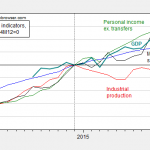Mike Gleason: It is my privilege now to welcome in Michael Pento, President and founder of Pento Portfolio Strategies and author of the book, The Coming Bond Market Collapse: How to Survive the Demise of the U.S. Debt Market. Michael is a well-known and successful money manager and has been a regular guest on CNBC, Bloomberg, Fox Business News, and also the Money Metals Podcast, and shares is astute insights on markets and geopolitics from the perspective of an Austrian School economist’s viewpoint.
Michael, welcome back. Thanks for joining us again and, how are you?
Michael Pento: I’m doing fine. Thanks for having me back on Mike.
Mike Gleason: Well, Michael, you focus a lot on the bond markets. Let’s talk for a minute here as we begin about the bubble that has been created and maintained there, and then we will get into the potential ramifications for precious metals. I was researching this morning and the yield on the 10-year Treasury note was 2.242% on December 20, 2015, just after the Federal Reserve made the first-rate hike in the current cycle of raising the Fed funds rate. Today, the 10-year yield is 2.327%, a tiny increase from two years ago, so the yield has barely budged despite the funds rate ratcheting up a full percentage point higher. Now, the funds rate isn’t directly tied to Treasury yields, but shouldn’t this tightening be translating to higher yields? Why is that not happening?
Michael Pento: What a great question to start off the show. So, I’ll just dovetail on what you just said and say that in the beginning of 2017, the yield on the 10-year note was 2.4%, or just around that level. Now, as you said, it’s 2.32%. So, there’s a very good reason for why this is happening because the long end of the bond market is concerned with inflation and if the Fed is hiking rates from pretty much zero to one and a quarter percent as we sit today, the effective Fed funds rate is just a little bit above 1%, that doesn’t mean that the yield should go higher on the long end of the yield curve. Actually, what that does mean, is that the Fed is vigilant, for now at least, on fighting inflation.
They’re reigning inflation out of the economy. That means the long end is going to come down to meet the short end, and I will tell you on that front that in the beginning of 2014, 260 basis points was the spread on the two and 10-year note. And we’ve had five rate hikes since then and guess what the spread is today as we record this interview, 51 basis points. So, you don’t have to have an advanced degree in calculus to figure out that you have two rate hikes left, two, assuming that the two-year note rises commensurately with the Fed funds rate, two rate hikes left before the yield curve is completely flat.
And the problem is that when I’m reading a lot of material in the past few days that the all-knowing pundits on Wall Street from the big brokerage houses, the big wire houses, are claiming that we’re going to have five rate hikes. Mike, five rate hikes between today, December 6th and the end of 2018, five. Not two, five. That means the Fed funds rate is going to be well above where the 10-year note yield is trading today, so you’re going to have a massively inverted yield curve by the end of 2018. Not only that, you pile onto the fact that central banks are going from a $120 billion worth of counterfeit confetti each month to zero by October. So, if you’re not worried about a recession, if you’re not worried about an inverted yield curve, if you’re not worried about the central banks moving their massive bid from stocks and bonds and if you’re not worried about the stock market imploding in the next few quarters, if not months, you should be.
Mike Gleason: Interest rates are essentially the price of risk and the market seems to be saying there just isn’t much. However, you and I both know there is plenty, as you just discussed there, but this is bubble has persisted for years now. The truth is we don’t have real properly functioning markets and this extraordinary mispricing of risk will go on until, and probably suddenly, it doesn’t. What signals are you watching for in the bond markets, if you would expand on that, that would indicate the game is about up and are you seeing any of those signs?













Leave A Comment